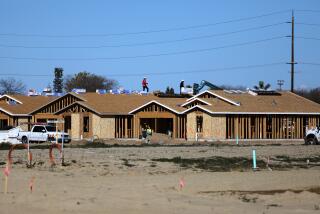12.9% Rise in Housing Starts Posted in 1994 : Construction: It was the strongest year since 1988. December rate dipped slightly after solid November gain.
- Share via
WASHINGTON — Builders broke ground on fewer new homes last month, the Commerce Department said Friday, but 1994 proved to be the strongest year for construction in six years despite escalating interest rates.
Starts on new single-family homes and apartments eased in December by a relatively moderate 1.0% to a seasonally adjusted annual rate of 1.53 million. That followed an upward revised jump of 7.6% in November from the 6.9% originally reported.
But for the full year, a total 1.45 million new homes were started, a sharp 12.9% rise from 1993. It was the most vigorous building rate since 1.49 million starts in 1988.
Economists and industry analysts said booming job growth and innovative financing, especially adjustable-rate mortgages, gave the housing sector surprising resilience in the face of costlier credit.
Unusually mild weather also helped builders, said economist Marilyn Schaja of Donaldson, Lufkin & Jenrette Securities Corp. in New York. “But the data nevertheless indicate that the rate of starts is hardly responding to higher mortgage interest rates.”
Mortgage rates rose steadily throughout 1994 as the Federal Reserve pushed short-term interest rates up six times to try to cool the pace of economic activity and sustain the expansion. The central bank is expected to raise rates again when its policy-setting committee meets Jan. 31 and Feb. 1.
The Federal Home Loan Mortgage Corp., or Freddie Mac, said a 30-year fixed rate mortgage carried a rate of 9.05% this week. It was the second straight week that rates fell, but they remain far above the low of 6.74% touched in October, 1993.
Consumers remain buoyant, however, with the University of Michigan Board reporting Friday that its consumer sentiment survey surged to 99.1 in January from 95.1 in December. The survey is issued only to paying customers.
“What’s really clear is that the continued improvement in employment . . . is finally allaying fears that there will be a new corporate downsizing and layoffs,” economist Ken Goldstein of the Conference Board said.
With national economic growth widely predicted to slow during the second half of this year, housing starts are seen declining by between 5% and 10% from 1994.
“Basically, we had a battle between the economy and interest rates in 1994 and the economy won,” said economist David Lereah of the Mortgage Bankers’ Assn.
“But these rates are just too high for sustained growth and they’re going to get worse before they get better,” he said, likely dragging 1995 housing starts down by as much as 9% from last year.
“Surveys are showing that builders generally are saying buyer traffic is down and sales are slowing,” said Tommy Thompson of Owensboro, Ky., president of the National Assn. of Home Builders. “We’re obviously seeing the impact of the rate increases.”
Applications for building permits--often a barometer of future activity--advanced 0.6% in December, to a 1.4 million rate.
Regionally, the West posted the largest starts increase last year, a 16.3% jump that included a 5.6% gain in December.
Starts rose 13.5% in the South, including a 4% increase in December.
Construction was up 10% in the Midwest, but in December it fell 11.8%.
In the Northeast, starts rose 8.4% despite a 10.7% drop in December.
* OC GAINS JOBS
Orange County’s unemployment rate fell to 4.1% in December. D2
(BEGIN TEXT OF INFOBOX / INFOGRAPHIC)
Housing Starts
Annual totals for housing starts, in millions of units:
1994: 1.45
Source: Commerce Department
More to Read
Inside the business of entertainment
The Wide Shot brings you news, analysis and insights on everything from streaming wars to production — and what it all means for the future.
You may occasionally receive promotional content from the Los Angeles Times.









